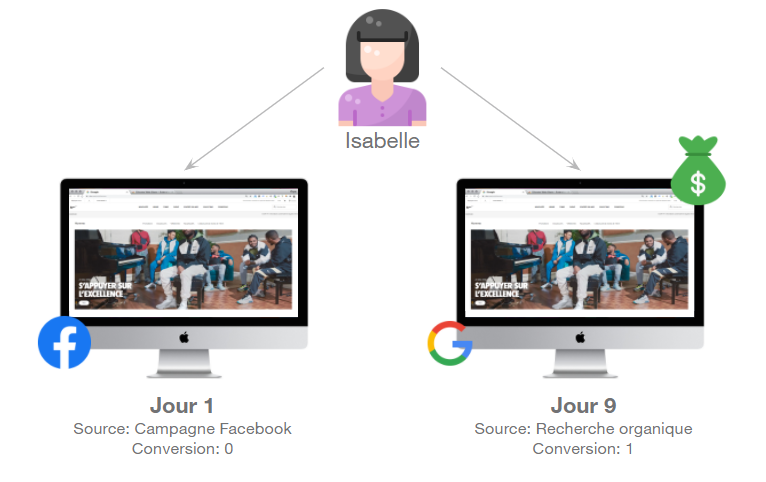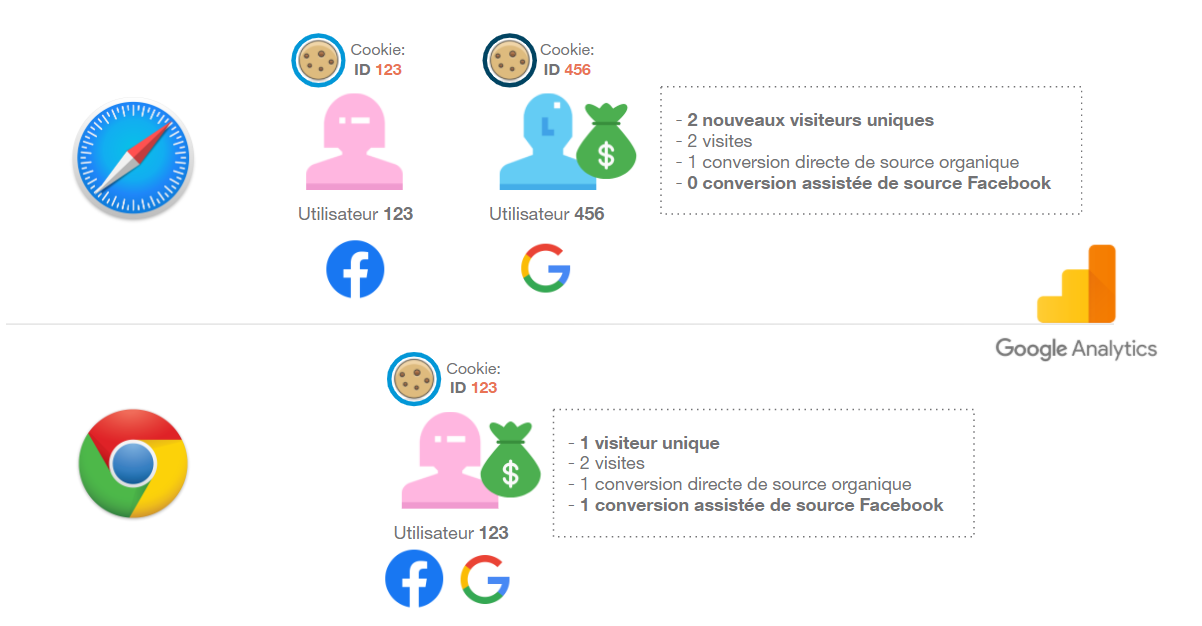Analytics and Data Science Consultant
Why the performance indicators you’re using will become less reliable
Analytics and Data Science Consultant
The challenge these days, given the cookie apocalypse, is to arrive at an understanding of the effects this transformation will have on the digital world. Today, we’re going to look more closely at its consequences for data measurement, otherwise known as analytics. So hold on to your hats—we’re about to re-evaluate several performance indicators you look at every day to measure your efficacy!
We will mainly be interested in the repercussions of the cookie apocalypse on first-party cookies. As opposed to third-party cookies, which tend to disappear, first-party cookies will remain relevant, but will undergo some major changes:
- the lifespan of first-party cookies will be restricted to 7 days (or even 24 hours in some cases) on the Safari browser;
- Firefox cookies will be deleted every day, unless there has been activity by the user within 45 days.
Changes to your daily processes
What is the result of this limited lifespan? It means it will be difficult to recognize a user from one visit to another, which will have repercussions on two elements:
- multichannel attribution of your consumer journeys across all of your digital marketing efforts and online business activities in general;
- direct (or 1-to-1) measurement of your entire performance on your Google or Adobe analytic platforms (meaning post-click conversions).
Let’s look at an example: Isabelle lands on www.monsite.com from a Facebook ad, browses a bit, then leaves the site. She returns nine days later through organic search to finally make a purchase.

The above is what happens in reality, but what is going on from the perspective of data collection?
- Day 1: A user 123 is identified, a visit coming from Facebook as a source is recorded.
- Day 9: A new user 456 is identified, a visit coming from organic search as a source and a conversion are recorded.
The following data will therefore be posted in Google Analytics, depending on whether Isabelle uses Google Chrome or Safari as a browser.

Given that Safari has limits when it comes to the lifespan of first-party cookies, this will have an influence on the following indicators:
- Number of unique visitors
- Number of new visitors
- Number of assisted conversions
- Distribution of direct conversions attributed by channel
- Acquisition cost
Do you see what’s happening? From now on, ask yourself the following questions when you’re reviewing the data:
- Is this the actual volume of new visitors? It’s possible you haven’t acquired as many new users as you think.
- Do the conversions attributed by channel represent reality? A declining conversion rate doesn’t necessarily indicate reduced performance!
- Do your CPA and ROAS represent reality if you’re only viewing them from the Google Analytics or Google Ads platform? On paper, the costs increase when you look at direct conversions (last click) and assisted conversions, but only last-click direct conversions remain the same.
There are a few reflections that should be integrated into your daily processes before sharing any data related to the performance of your marketing activities. The cookie apocalypse also affects all optimization activities and content personalization. Your consideration of A/B test results must also take this into account. Learn more about this topic by reading this article written by my colleague Nicolas Duval.
Download our preparatory guide to the cookie apocalypse
The future of performance measurement
So what should be done in the short term?
- In your reports, take into account a margin of error for your analyses based on the proportion of your traffic coming from Safari and Firefox.
- Avoid cross-referencing or comparing first-party data for clicks or conversions in Google or Adobe Analytics with those from Adtech platforms, which depend on third parties. The margin of error will only increase.
- In Google or Adobe Analytics, take into consideration the margin for error in the analysis of the client journey, based on the percentage of traffic coming from Safari and Firefox.
- Note that if you add UTM parameters to your campaigns, the lifespan of your first-party cookies in Safari will be 24 hours instead of 7 days.
- Exclude the Safari browser from your experimental testing (A/B, MVT).
In the longer term, many things are about to be transformed and implemented. The watchword for 2021 will be “Adapt!” Whether it comes to platforms, processes or human involvement, you’re going to need a lot of flexibility to deal with the upheaval.
Performance analysis with GA4, BigQuery and MMM
Google is in the process of developing a platform called GA4. With GA4, Google will democratize the analysis of big data through the integration of BigQuery. Companies will be able to export, for free, their GA4 data to BigQuery to effect high-powered analyses, or even to enrich their CRM data before sending it to other platforms. To learn more about 4 big reasons to activate GA4 in 2021, click here!
Another trend being seen in the industry is the return of statistical inference models (The Drum and Parker, 2020). More particularly, this marks the return of one of the most used methods in marketers’ arsenals before the advent of the digital era: marketing mix modelling (MMM). Instead of analyzing the performance of digital media campaigns in silos, you analyze the repercussions of all marketing activities on sales, both online and offline. As an organization gains in maturity in terms of data use, it also becomes possible to add other internal and external factors to obtain an even more complete view (weather, price indexes of the competition, etc.).
Where should you start to correctly measure performance in 2021?
To navigate through this changing industry and enable reliable and robust modelling, it’s important to properly integrate tagging platforms to capture a maximum of data points, which will fuel the models for various platforms.
In order to limit the loss of data captured by your client-side media or analytics platforms (on the webpage), some “new” (or, rather, old 😉) pixel or tracker integration methods will come back into fashion—in other words, server-side tracking. From now on, Google Tag Manager will permit server-side integration to enable new, more robust tracking methods than those available on the client side (Google, 2021). But be careful—server-side tracking doesn’t give you the right to sidestep legal regulations for managing user data. Nevertheless, this type of integration will become necessary for many organizations, from the point of view of both measurement and audience creation, since it will enable you to play around with the limited lifespan of first-party cookies.
Finally, you can also maximize the collection of primary data through identifying users who have an online account. The exploitation of customer data platforms (CDP) will become an increasingly interesting option. It would therefore be wise to put some effort into building a solid base of user data.
Human training will be a focus
Whenever you start talking about new platforms, new technologies and new processes, you’re also talking about training. In fact, it will be essential to invest in training the people who are at the heart of your marketing activities in order to be able to progress with confidence in your future initiatives.
These people (such as you!) will first and foremost need to:
- thoroughly understand the issues involved in the cookie apocalypse in order to master the use of current data;
- adapt their marketing activities, starting today;
- consider strategies in the medium and long term that could be established within their company—GA4, BigQuery, CDP, MMM, and so on.
So what should we do?
Perfect solutions don’t exist—or at least, they don’t exist yet. On the other hand, above all else, it’s important to understand the changes that affect measurement and adapt our data analysis based on the new rules of the game. We will therefore need to constantly adapt and continue to demonstrate ingenuity to optimize our marketing tactics.
We’re currently living through a period of great change. This is a golden opportunity to get a head start and create a competitive advantage for yourself. Even in the midst of a storm, it is possible to stand apart from the competition.
Visit our special section dedicated to the Cookie Apocalypse to learn more about it

-1.png)







